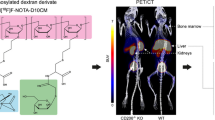Abstract
Objective: Research on FDG-uptake by blood cells has revealed that FDG is incorporated by macrophages and granulocytes, as well as activated lymphocytes. These characteristics of FDG suggest the possibility of visualizing the distribution of immunocytes in target organs. The aim of this study was to investigate if mouse spleen-derived lymphocytes, activated by macrophages presenting sheep red blood cell (sRBC) antigens, could be traced by FDG.Methods: One percent of a sRBC suspension was injected into the peritoneal cavity of mice thereby creating immunity to the sRBC antigen. The splenocytes, consisting mostly of lymphocytes, were isolated, and serum containing the anti-sRBC antibody was mixed with sRBC to prepare sRBC-antibody complexes (sRBC-AbCs). Then five percent of a thioglycolate medium was injected into the peritoneal cavity of the same mice, and macrophages of ascitic cell origin were obtained. These macrophages were added to the sRBC-AbCs to induce sRBC antigen presenting macrophages. These were incubated with splenocytes obtained from sRBC immunized mouse (sRBC immunized splenocytes) or nonimmunized splenocytes to induce a T cell immune response. [3H]deoxyglucose ([3H]DG) and FDG were incorporated in splenocytes, and the quantity of their uptake was measured.Results: [3H]DG uptake by sRBC-immunized splenocytes was about eleven times as high as that of non-immunized splenocytes. In contrast, [3H]DG uptake by sRBC-immunized splenocytes, co-cultured with macrophages phagocytizing sRBC-AbCs, was about 40 times higher compared with non-immunized splenocytes. Splenocytes in non-immunized mice picked up very little [3H]DG, despite co-culture with macrophages phagocytizing sRBC-AbCs. Similar tendencies were observed with FDG.Conclusions: These results suggest that the SUV calculated in PET reflects not only the number of lymphocytes, but also the activation state of the lymphocytes themselves. In addition, the biodistribution of antigen specific lymphocytes, that have been taken up FDGin vitro and returned to the body, can be observed through PET.
Similar content being viewed by others
References
Bar-Shalom R, Valdivia AY, Blaufox MD. PET imaging in oncology.Semin Nucl Med 2000; 30: 150–185.
Nirenberg MW, Hogg JE. Inhibition of anaerobic glycolysis in ehrlich ascites tumor cells by 2-deoxy-d-glucose.Cancer Res 1958; 18: 518–521.
Macfarlane DJ, Cotton L, Ackermann RJ, Minn H, Ficaro EP, Shreve PD, et al. Triple-head SPECT with 2-[fluorine-18] fluoro-2-deoxy-d-glucose (FDG): initial evaluation in oncology and comparison with FDG PET.Radiology 1995; 194: 425–429.
Martin WH, Delbeke D, Patton JA, Sandler MP. Detection of malignancies with SPECT versus PET, with 2-[fluorine-18]fluoro-2-deoxy-d-glucose.Radiology 1996; 198: 225–231.
Patz EF, Lowe VJ, Hoffman, JM, Paine SS, Harris LK, Goodman PC. Persistent or recurrent bronchogenic carcinoma: detection with PET and 2-[F-18]-2-deoxy-d-glucose.Radiology 1994; 191: 379–382.
Strauss LG, Clorius JH, Schlag P, Lehner B, Kimmig B, Engenhart R, et al. Recurrence of colorectal tumors: PET evaluation.Radiology 1989; 170: 329–332.
Fischbein NJ, AAssar OS, Caputo GR, Kaplan MJ, Singer MI, Price DC, et al. Clinical utility of positron emission tomography with18F-fluorodeoxyglucose in detecting residual/recurrent squamous cell carcinoma of the head and neck.Am J Neuroradiol 1998; 19: 1189–1196.
Bakheet SM, Powe J, Eaat A, Rostom A. Benign causes of18FDG uptake on whole body imaging.Semin Nucl Med 1998; 28: 352–358.
Shreve PD, Anzai Y, Wahl RL. Pitfalls in oncologic diagnosis with FDG PET imaging: physiologic and benign variants.Radiographics 1999; 19: 61–77.
Rau FC, Weber WA, Wester HJ, Herz M, Becker I, Kruger A, et al.O-(2-[(18)F]Fluoroethyl)-l-tyrosine (FET): a tracer for differentiation of tumour from inflammation in murine lymph nodes.Eur J Nucl Med 2002; 29: 1039–1046.
Bushart GB, Vetter U, Hartmann W. Glucose transport during cell cycle in IM9 lymphocytes.Horm Metab Res 1993; 25: 210–213.
Kruisbeek AM.In vitro assays for mouse lymphocyte function. InCurrent Protocols in Immunology, National Institutes of Health, Colian JE, et al. (eds), 1997: 3.0.1–3.22.4.
Harding CV, Antigen processing and presentation. InCurrent Protocols in Immunology, National Institutes of Health, Colian JE, et al. (eds), 1997: 16.0.1–16.2.15.
Gallagher BM, Fowler JS, Gutterson NI, MacGregor RR, Wan CN, Wolf AP. Metabolic trapping as a principle of radiopharmaceutical design: some factors responsible for the biodistribution of [18F]2-deoxy-2-fluoro-d-glucose.J Nucl Med 1978; 19: 1154–1161.
Janeway CA, Travers P, Walport M, Capra JD. The induction, measurement, and manipulation of the immune response. In:Immunobiology—The Immune System in Health and Disease, 4th ed., NY; Garland Publishing, 1999: 33–76.
Kubota R, Kubota K, Yamada S, Tada M, Ido T, Tamahashi N. Microautoradiographic study for the differentiation of intratumoral macrophages, granulation tissues and cancer cells by the dynamics of fluorine-18-fluorodeoxyglucose uptake.J Nucl Med 1994; 35: 104–112.
Shimokawara I, Imamura M, Yamanaka N, Ishii Y, Kikuchi K. Identification of lymphocyte subpopulations in human breast cancer tissue and its significance: an immunoperoxidase study with anti-human T- and B-cell sera.Cancer 1982; 49: 1456–1464.
Kikuchi K, Shimokawara I, Takami T, et al. Distribution of T and B cells in human cancer tissue. InImmunobiology and Immunotherapy of Cancer (Development in Immunology 6), Terry W, Yamamura Y (eds), New York; Elsevier/North-Holland, 1979: 263.
Hiratsuka H, Imamura M, Kasai K, Kamiya H, Ishii Y, Kohama G, et al. Lymphocyte subpopulations and T-cell subsets in human oral cancer tissues: immunohistologic analysis by monoclonal antibodies.Am J Clin Pathol 1984; 81: 464–470.
Kawabe J, Okamura T, Shakudo M, Koyama K, Sakamoto H, Ohachi Y, et al. Physiological FDG uptake in the palatine tonsils.Ann Nucl Med 2001; 15: 297–300.
Hamberg LM, Hunter GJ, Alpert NM, Choi NC, Babich JW, Fischman AJ. The dose uptake ratio as an index of glucose metabolism: useful parameter or oversimplification?J Nucl Med 1994; 35: 1308–1312.
Author information
Authors and Affiliations
Corresponding author
Rights and permissions
About this article
Cite this article
Shozushima, M., Tsutsumi, R., Terasaki, K. et al. Augmentation effects of lymphocyte activation by antigen-presenting macrophages on FDG uptake. Ann Nucl Med 17, 555–560 (2003). https://doi.org/10.1007/BF03006668
Received:
Accepted:
Published:
Issue Date:
DOI: https://doi.org/10.1007/BF03006668



